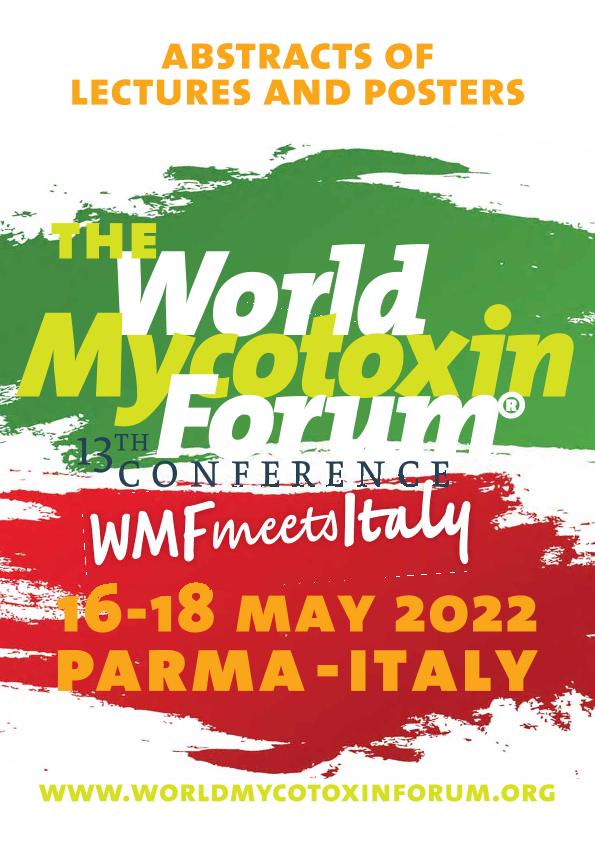Mostrar el registro sencillo del ítem
dc.contributor.author
Erazo, Jessica Gabriela

dc.contributor.author
Palacios, Sofia Alejendra

dc.contributor.author
del Canto, Agostina

dc.contributor.author
Plem, Silvana Cristina

dc.contributor.author
Ramirez, Maria Laura

dc.contributor.author
Torres, Adriana Mabel

dc.date.available
2024-04-16T17:42:56Z
dc.date.issued
2022
dc.identifier.citation
Effect of water activity and temperature on growth and trichothecene production by Fusarium cerealis isolated from durum wheat grains; The World Mycotoxin Forum 13th Conference; Parma; Italia; 2022; 150-150
dc.identifier.uri
http://hdl.handle.net/11336/233204
dc.description.abstract
The major pathogen associated to fusarium head blight (FHB) is included in the Fusarium graminearum species complex. However, recently there have been reports of F. cerealis causing the disease in wheat and barley. This pathogen is able to produce deoxynivalenol (DON) and nivalenol (NIV). Nevertheless, the effect of environmental factors on growth and mycotoxin production by this species have not been studied so far. The aim of this study was to determine the effect of water activity (aw, 0.99?0.90) and temperature (15, 20, 25 and 30°C) on growth and DON and NIV production by three F. cerealis strains (RCFG6046, RCFG6029, RCFG6076) isolated from durum wheat grains. A wheat-based medium was used and adjusted to the different aW with glycerol. Plates were inoculated centrally and incubated during 28 days (three replicates per treatment). Growth rate (mm/day) was determined and mycotoxin production was analyzed after the incubation period by HPLC-UV. All strains were able to growth at all temperatures and all aW except at 0.90. Maximum growth was observed at 0.99 and 25°C and it decreased as water availability was reduced. Minimum growth was observed at 0.93 aW and 15°C. Mycotoxin production was strain dependent. Strains RCFG6046 and RCFG6076 produced both DON and NIV, being NIV the most produced. While RCFG6029 just produced DON. Strains RCFG6029 and RCFG6046 just produced DON at the optimum growth condition unlike RCFG6076 which produced only NIV. For some conditions, RCFG6076 was able to produce both toxins simultaneously in contrast to RCFG6046 which cannot produce both toxins at the same time. Maximum NIV production (9796.5 µg/kg) was observed for RCFG6076 at 0.97 aw and 30°C and the minimum level (1075.57 µg/kg) was detected at 0.95 aw and 15°C for the same strain. No NIV was detected at 0.93 aW at any temperature. DON production was observed for all conditions tested. The highest DON concentration (2954.35 µg/kg) was produced at 0.93 aw and 30°C for strain RCFG6076 while the minimum was detected at 0.99 aw and 20°C for the same strain. In conclusion, F. cerealis was able to produce both toxins in a wide range of aW and temperatures however this production was strain dependent. Maximum levels were produced during stress conditions and NIV was produced in high levels. Considering that NIV is more toxic than DON, this presents a risk for human consumption since these strains were isolated from durum wheat.
dc.format
application/pdf
dc.language.iso
eng
dc.publisher
Bastiaanse Communication
dc.rights
info:eu-repo/semantics/openAccess
dc.rights.uri
https://creativecommons.org/licenses/by-nc-sa/2.5/ar/
dc.subject
Fusarium cerealis
dc.subject
Ecophysiology
dc.subject
Deoxynivalenol
dc.subject
Nivalenol
dc.subject.classification
Micología

dc.subject.classification
Ciencias Biológicas

dc.subject.classification
CIENCIAS NATURALES Y EXACTAS

dc.title
Effect of water activity and temperature on growth and trichothecene production by Fusarium cerealis isolated from durum wheat grains
dc.type
info:eu-repo/semantics/publishedVersion
dc.type
info:eu-repo/semantics/conferenceObject
dc.type
info:ar-repo/semantics/documento de conferencia
dc.date.updated
2024-02-28T10:38:13Z
dc.journal.pagination
150-150
dc.journal.pais
Holanda
dc.journal.ciudad
Bilthoven
dc.description.fil
Fil: Erazo, Jessica Gabriela. Universidad Nacional de Río Cuarto. Facultad de Ciencias Exactas Fisicoquímicas y Naturales. Instituto de Investigación en Micología y Micotoxicología. - Consejo Nacional de Investigaciones Científicas y Técnicas. Centro Científico Tecnológico Conicet - Córdoba. Instituto de Investigación en Micología y Micotoxicología; Argentina
dc.description.fil
Fil: Palacios, Sofia Alejendra. Universidad Nacional de Río Cuarto. Facultad de Ciencias Exactas Fisicoquímicas y Naturales. Instituto de Investigación en Micología y Micotoxicología. - Consejo Nacional de Investigaciones Científicas y Técnicas. Centro Científico Tecnológico Conicet - Córdoba. Instituto de Investigación en Micología y Micotoxicología; Argentina
dc.description.fil
Fil: del Canto, Agostina. Universidad Nacional de Río Cuarto. Facultad de Ciencias Exactas Fisicoquímicas y Naturales. Instituto de Investigación en Micología y Micotoxicología. - Consejo Nacional de Investigaciones Científicas y Técnicas. Centro Científico Tecnológico Conicet - Córdoba. Instituto de Investigación en Micología y Micotoxicología; Argentina
dc.description.fil
Fil: Plem, Silvana Cristina. Universidad Nacional de Río Cuarto. Facultad de Ciencias Exactas Fisicoquímicas y Naturales. Instituto de Investigación en Micología y Micotoxicología. - Consejo Nacional de Investigaciones Científicas y Técnicas. Centro Científico Tecnológico Conicet - Córdoba. Instituto de Investigación en Micología y Micotoxicología; Argentina
dc.description.fil
Fil: Ramirez, Maria Laura. Universidad Nacional de Río Cuarto. Facultad de Ciencias Exactas Fisicoquímicas y Naturales. Instituto de Investigación en Micología y Micotoxicología. - Consejo Nacional de Investigaciones Científicas y Técnicas. Centro Científico Tecnológico Conicet - Córdoba. Instituto de Investigación en Micología y Micotoxicología; Argentina
dc.description.fil
Fil: Torres, Adriana Mabel. Universidad Nacional de Río Cuarto. Facultad de Ciencias Exactas Fisicoquímicas y Naturales. Instituto de Investigación en Micología y Micotoxicología. - Consejo Nacional de Investigaciones Científicas y Técnicas. Centro Científico Tecnológico Conicet - Córdoba. Instituto de Investigación en Micología y Micotoxicología; Argentina
dc.relation.alternativeid
info:eu-repo/semantics/altIdentifier/url/https://www.bastiaanse-communication.com/WMF2021-2022/
dc.conicet.rol
Autor

dc.conicet.rol
Autor

dc.conicet.rol
Autor

dc.conicet.rol
Autor

dc.conicet.rol
Autor

dc.conicet.rol
Autor

dc.coverage
Internacional
dc.type.subtype
Conferencia
dc.description.nombreEvento
The World Mycotoxin Forum 13th Conference
dc.date.evento
2022-05-16
dc.description.ciudadEvento
Parma
dc.description.paisEvento
Italia

dc.type.publicacion
Book
dc.description.institucionOrganizadora
Universidad de Parma
dc.source.libro
Abstracts of lectures and posters: World Mycotoxin Forum. 13th conference
dc.date.eventoHasta
2022-05-18
dc.type
Conferencia
Archivos asociados
